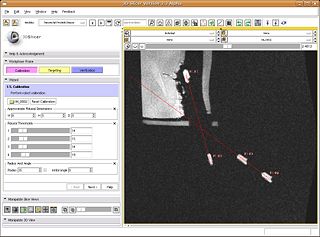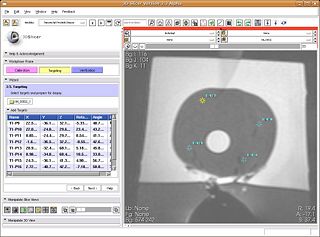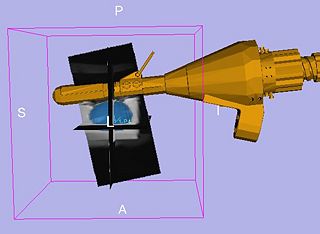DBP2:Queens:Roadmap
Back to NA-MIC Internal Collaborations, JHU DBP 2
Objective
We would like to create an end-to-end application within the NA-MIC Kit to enable an existing transrectal prostate biopsy device to perform multi-parametric MRI guided prostate biopsy in closed-bore high-field MRI magnets.
This page describes the technology roadmap for robotic prostate biopsy in the NA-MIC Kit. The basic components necessary for this application are:
- Tissue segmentation: Should be multi-modality, correcting for intensity inhomogeneity and work for both supine and prone patients, all imaged with an endorectal coil (ERC).
- Registration: co-registration of MRI datasets taken at different times, in different body positions, and under different imaging parameters
- Prostate Measurement: Measure volume of all segmented structures
- Biopsy Device Parameters: Geometry, kinematics, and calibration/registration of the robot system must be available in some form. This capability is not currently part of the NA-MIC kit. The application will be modular, to enable use of different devices.
- Tutorial: Documentation will be written for a tutorial and sample data sets will be provided to perform simulated biopsies.
Slicer Transrectal Prostate Biopsy Module
The primary goal for the roadmap is to develop an interventional module for Slicer3 for MRI-guided prostate biopsies. This module and the accompanying tutorial will serve as a template for interventional applications with Slicer3.
The module will provide the necessary functionality for calibrating the robot to the MR scanner, planning biopsies, computing the necessary robot trajectory to perform each biopsy, and verification via post-biopsy images.
Roadmap
We will obtain a biopsy plan from multi-parametric endorectal image volumes, executable with an existing prostate biopsy device. The system will be will be implemented under Slicer3 as an interactive application.
Current Status of System Components
- Segmentation: Semi-automatic segmentation has been implemented by Fichtinger et al. Statistical atlas based segmentation has been prototyped by Tannenbaum et al. Pose-independent segmentation (workable in both supine/prone) is being implemented.
- Registration: contour based registration has been prototyped by Fichtinger et al., needs to be re-implemented with native NA-MIC tools.
- Prostate Measurement: Prototyped by Fichtinger et al., needs to be re-implemented with native NA-MIC tools.
- Device Modeling: Prototyped by Fichtinger et al, needs to be re-implemented with native NA-MIC tools.
- Biopsy Planning: Clinically functional, needs to be implemented with native NA-MIC tools
- Tutorial: Not yet started. It will be derived from the actual clinically-functional system, with demo data.
Schedule
Data Collection: Done. Initial data available, hand segmented for ground truth.
Segmentation: We plan to use shape-based segmentation methods for the MRI prostate data. Several parts of the procedure have already been implemented with NA-MIC tools such as the conformal flattening procedure. Spherical wavelets for shape analysis are already available in ITK. Despeckling techniques will be used to enhance ultrasound imagery as a pre-processing step for segmentation of the prostate data.
System Implementation: Apart from the one research element (segmentation), the rest of the project is a massive software engineering effort, and will follow these major milestones and schedule:
Application Workflow Development:
10/15/2007 Define the workflow for the application (David, Csaba, Gabor) --- DONE ---
10/22/2007 Create GUI templates for the workflow steps (David) --- DONE ---
Device Modeling:
12/15/2007 Conversion of engineering data into VTK-viewable objects (David) -- DONE --
Data Display:
12/15/2007 Provide display logic for targets and prostate outlines (David) --- DONE ---
Measurement Tools:
07/01/2008 Semi-automatic identification of fiducials via thresholding & centroids (Csaba) --- DONE ---
07/01/2008 Logic for robot registration with fiducials (Csaba) --- DONE ---
08/01/2008 Prostate measurement tools (use existing NA-MIC tools) (David) --- IN PROCESS ---
Biopsy Planning:
07/01/2008 Calculations for robot trajectory based on target position (Csaba) --- DONE ---
08/08/2008 Implement planning tools (display, logic) in Slicer3 (David) --- MOSTLY DONE ---
08/15/2008 Verification against pre-existing software and data (David, Siddharth)
Robot positioning:
08/22/2008 Integrate optical encoders with our Slicer module (David)
08/22/2008 GUI targeting readouts for optical encoders (David, Siddharth)
Integration of contour-based prostate display into Slicer3:
08/29/2008 2D Contour outline display of 3D models in Slicer (David)
Verification and testing of integrated system
09/12/2008 Workflow validation (Siddharth, David)
09/12/2008 Complete testing, performance characterization (Siddharth)
Tutorial and Documentation
Continuous unit documentation (David)
09/26/2008 Complete tutorial with example data
Team and Institutes
- PI: Gabor Fichtinger, Queen’s University (gabor at cs.queensu.ca)
- Co-I: Purang Abolmaesumi, Queen’s University (purang at cs.queensu.ca)
- Software Engineer Lead: David Gobbi, Queen’s University (dgobbi at cs.queensu.ca
- Software Engineer Support: Siddharth Vikal, Queen’s University (siddharthvikal at yahoo.com)
- JHU Software Engineer Support: Csaba Csoma, Johns Hopkins University, csoma at jhu.edu
- NA-MIC Engineering Contact: Katie Hayes, MSc, Brigham and Women's Hospital, hayes at bwh.harvard.edu
- NA-MIC Algorithms Contact: Allen Tannenbaum, PhD, GeorgiaTech, tannenba at ece.gatech.edu
- Host Institutes: Queen's University & Johns Hopkins University


